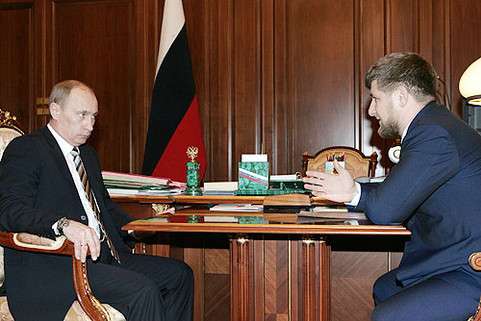
Who are the most likely candidates for secession in Russia's south, east, and centre? (Photo: Wikimedia)
Increasingly, analysts — both inside and outside of Russia — are considering the possibility of the Russian Federation’s collapse and transformation into a series of independent states.
Russia’s disastrous war with Ukraine is straining an already weak economy, undermining the legitimacy and strength of the regime, exposing the Russian armed forces as a paper tiger, and weakening Vladimir Putin’s standing among the elites.
-

Chechen strongman Ramzan Yadyrov (right), with Vladimir Putin (Photo: Wikipedia)
At some point, the whole system could conceivably come crashing down—a scenario that has become thinkable, even if its likelihood is still indeterminate.
Who are the most likely candidates for secession in Russia’s south, east, and centre?
South
Ingushetia, Chechnya, and Dagestan have a combined population of 5.2 million.
In the last decade, it has grown over 13 percent. All three polities exhibit strong national identities, practice Islam, and have resorted to anti-Russian violence in the past.
Chechnya stands out, having waged a decades-long war against Russia in the 19th century and two wars of national liberation in the 1990s. Its current leader, the authoritarian strongman Ramzan Kadyrov, enjoys extensive autonomy and, given appropriate incentives, could easily turn his back on Moscow.
Following the end of major fighting in the second Chechen war in April 2000, Chechen insurgent and terrorist activity continued into the 2010s. It began with the October 2002 and September 2004 school hostage-takings, that resulted in numerous fatalities.
Subsequently, there were several bombings: in March 2010 in the Moscow Metro, in January 2011 at Moscow’s Domodedovo airport, and in December 2013 at the Volgograd train station. The bombings were claimed by the Caucasus Emirate, a more radical affiliation of Chechen, Ingush, and Dagestani militants.
East
The key polities in Russia’s far east are Sakhalin Province, Primorskiy Region, Khabarovsk Region, Kamchatka Region, and the Sakha Republic (also known as Yakutia), which comprise 1.6 million square miles. The first four territories are inhabited primarily by Russians; Sakha is home to the Yakuts.
The combined population of the Russian regions is 3.6 million; that of Yakutia is 990,000. The former declined by 4.1 percent in the last decade, while the latter grew by 3.3 percent. These five territories have considerable mineral wealth.
Financed and developed in the early 2000s by US and Japanese-led consortiums, Sakhalin has sizeable world-class oil and natural gas production and export facilities. Primorskiy Region has several ports that are key to Russia’s Pacific trade. The port of Kozmino is the terminus for the Eastern Siberia—Pacific Ocean (ESPO) crude oil pipeline (nameplate capacity of 1.6 million barrels per day). During 2021 ESPO average daily transit was 720 thousand barrels per day. Kozmino’s neighbouring port of Vostochny exports coal to China, Japan, Korea, and Taiwan.
The bedrock of Yakutia’s economy is mining. Almost 100 percent of Russia’s diamond mining and processing takes place within the territory. In addition, the primary source of Russia’s coal exports that are shipped through Kozmino is Yakutia. The combined annual output of gold in Yakutia and Khabarovsk is equal to 64 metric tons, or over 20 percent of Russia’s total.
Although the Yakuts are a minority in their own republic, they have experienced a national revival in recent decades, as their adoption of the indigenous name Sakha indicates. Khabarovsk, meanwhile, was at the centre of regular mass demonstrations between July 2020 and July 2021.
Sparked by Moscow’s dismissal of a popular governor, these protests testify to growing anti-Moscow feeling in the territory.
Centre
Of Russia’s 85 political divisions, Tatarstan and Bashkortostan are two of the few that have a unique constitutional arrangement granting them considerable autonomy. Together, they have a population of almost eight million that has increased about 0.4 percent over the last decade.
The republics are home to Russia’s legacy crude oil production producing about 1 million barrels per day, or about 10 percent of Russia’s total. Tatarstan alone has approximately 7.3 billion barrels in reserves, or 30 years of supply at current production rates.
In addition to hydrocarbon production, the two regions are, in comparison to the rest of Russia, diversified economically, having strong manufacturing and agricultural sectors. The regions have access to several river systems as well as railways putting them at the crossroads of trade routes. Together they have a high net export trade balance with exports of $15bn [€14.2bn] and imports of $1.6bn
During the 1990s after the dissolution of the Soviet Union, Tatarstan took steps through referendums and agreements with the Kremlin to achieve full sovereignty.
When Russia acknowledged the sovereignty of Abkhazia and South Ossetia after Russia’s August 2008 invasion of Georgia, Tatarstan declared itself independent and asked the United Nations and Russia for recognition.
Both ignored the request.
If Russia’s war against Ukraine leads to victory for Ukraine or a stalemated quagmire, the instability of the Putin regime will grow exponentially. Under such conditions, some of the Russian Federation’s regions are likely to bolt, especially if the Kremlin remains preoccupied with the power struggle over Putin’s crown.
Will the new states remain independent, or will they be ingathered by whoever replaces Putin? We don’t know. All we can say with any degree of certainty is that reintegrating them into Russia will be a violent and bloody process that could as easily accelerate Russia’s collapse as revive the federation.
Source: euobserver.com



